Your Planets
Portraits of the Planets
Aspects between Planets
The planetary ages
The planetary families
Planets in Signs
The Planets in comics


In traditional astrology, planetary retrogradations have a very bad reputation. At best, they would weaken the influence of the retrograde planet; at worst, they would make it work in a perverse mode. For karmic astrology, who uses and abuses it, the retrogradations would testify to the karmic debts that we would have accumulated in our previous reincarnations, debts that resemble like sisters to their “curses” supposed by classical astrology. Conditionalist astrology has never really gone into the problems that they can induce and the questions that they can pose in the interpretation.
The apparent motion of a planet results from the interaction between its real motion and that of the Earth. Demotions are therefore not “optical illusions”: they are induced by the different angular velocities of the Earth and the planet. As Jean-Pierre Nicola points out, “a little astrometry and kinematics is enough to understand the inseparability of the two heliocentric and geocentric systems: our ‘appearances’ are directly a function of the real speeds and positions of the stars and, therefore, of the real configuration of the solar system… therefore, laws, always efficient, which determine the distribution of the orbits, the planetary movements and the coherence of the whole…”

The apparent movement according to whether it is a question of the “inner” planets to Earth orbit (Mercury and Venus) or “outer” planets (from Mars to Pluto).


For an interior planet, the apparent movement is direct in superior conjunction (it is then behind the Sun), and retrograde in inferior conjunction (it is then in front of the Sun).
For an outer planet, the apparent motion is direct in conjunction with the Sun and retrograde in opposition to the Sun. The retrogradation phenomenon is explained in detail in this section.
When a planet is retrograde, its declination is inverse to what it is when it is clockwise.
Let’s take a concrete example. 1st January 1964, Uranus is retrograde at 9° 57′ Virgo. Its declination is 8° 34′ N, and it lies above the equator, not far from the intersection between the equator and the ecliptic which determines the autumnal equinox. Due to its retrogradation, its northern declination is increasing and corresponds to that of the Sun at 22° Aries. Would Uranus retrograde in Virgo turn into Uranus-Aries? In this case, should we interpret a Uranus-Aries rather than a Uranus-Virgo?
It is not so simple. As Jean-Pierre Nicola points out, “To change Sign because the declination goes from growth to decrease or the opposite because of the retrogradation, it is to eradicate the right ascension component of the position of the star (hence an absurdity) and isolate the retrogradation, to extract it as a phenomenon apart from the synodical revolution. A vehicle which, on a hill, reverses, is not a vehicle which rises, nor a vehicle which takes a leap in time to return to the past. Retrogradation is part of a cycle. It is enough to take the trouble to draw a graph of variation of declination (other than Sun, Moon) to understand and visualize the retrogradation by an ‘anomaly’ on the average curve.”
If right ascension is not taken into account, retrograde Uranus-Virgo can be just as easily at 22° Aries as at 8° Virgo. This is indeed nonsense. In other words, retrograde Uranus in Virgo is indeed in Virgo if we refer to its right ascension, but this Virgo rhythm is periodically disturbed by Aries-type irruptions if we refer to the declinations.
The graph of the variations of declinations of Uranus-Virgo below shows that the general trend is indeed the decrease of the North declination.
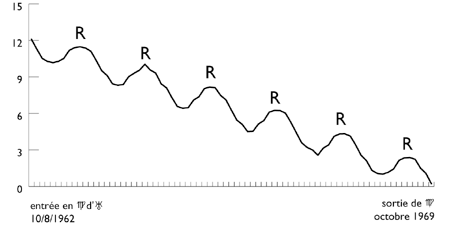
Would the problem be solved? Not yet. Let’s leave the universal zodiac of declinations for the photoperiodic zodiacs specific to each terrestrial latitude and start with the most obvious case: that of the two terrestrial hemispheres. When it is the end of summer in the northern hemisphere, it is the end of winter in the southern hemisphere.
When it is in direct direction, our Uranus-Virgo has a photoperiodic rhythm of type “Pisces” in the southern hemisphere and, when retrograde, a photoperiodic rhythm “Aries” for the Northern Hemisphere and “Libra” for the Southern Hemisphere. The tables below summarize the photoperiodic rhythms for the two hemispheres.
Does it make you dizzy? Wait, it’s not over. I will take just one example: the inhabitants of the equatorial zone, i.e. between 500 and 600 million people. In these latitudes, the day-night alternation is monotonous: 12 hours of day, twelve hours of night. So would they all be Aries, Virgo, Libra or Pisces? Yes, if it is the photoperiodic zodiac which is the most decisive in relation to the declination zodiac. But then, what to do with those who have nevertheless committed the thoughtlessness of being born around the solstices, these unfortunate Gemini, Cancer, Sagittarius and Capricorn forced to live under equinoctial photoperiods, i.e. approximately 200 million people?
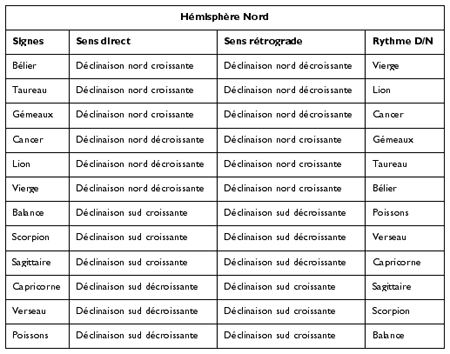
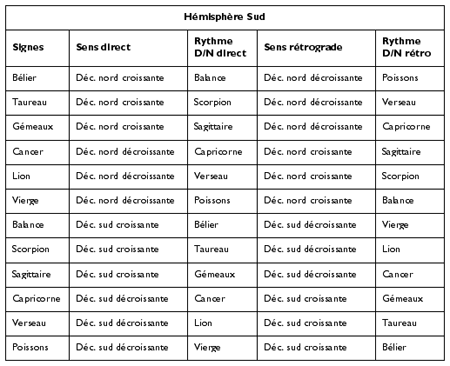
Jean-Pierre Nicola already mentioned this issue in his Comparative balance sheets about specific conditionalist zodiac references: “The cycle of variation of the duration of presence (diurnal arc) of a star above the plane of the horizon. This cycle being both a function of the geographical latitude of the observer and of the declination of the observed star, it is necessary to design zodiacs relating to places and a universal zodiac, the effects — possible — of their interference appearing among the questions treat.”
 Here is what I wrote about it in my Manuel: “The most likely hypothesis is that of the interference of the effects of declination and photoperiod. In this view, a Capricorn remains a Capricorn regardless of the latitude at which he was born, but there would be various types of Capricorn, which can be reduced to a minimum of four: the equatorial Capricorn, the tropical, the temperate and the polar ones… And the same obviously goes for all the other Signs. In this hypothesis, it is not impossible that the declination-photoperiod superposition increases the zodiacal-planetary effects in the North and decreases them in the South. Astrology was born and developed in the temperate zones of the northern hemisphere, and in ancient history there is no trace of an astrology worthy of the name in the southern hemisphere, despite the great civilizations who deployed there. One can wonder if this is not due to the fact that the zodiaco-planetary effects are more evident in the North than in the South… This is the unknown: we have not finished elucidating the mysteries and enigmas of astrology.”
Here is what I wrote about it in my Manuel: “The most likely hypothesis is that of the interference of the effects of declination and photoperiod. In this view, a Capricorn remains a Capricorn regardless of the latitude at which he was born, but there would be various types of Capricorn, which can be reduced to a minimum of four: the equatorial Capricorn, the tropical, the temperate and the polar ones… And the same obviously goes for all the other Signs. In this hypothesis, it is not impossible that the declination-photoperiod superposition increases the zodiacal-planetary effects in the North and decreases them in the South. Astrology was born and developed in the temperate zones of the northern hemisphere, and in ancient history there is no trace of an astrology worthy of the name in the southern hemisphere, despite the great civilizations who deployed there. One can wonder if this is not due to the fact that the zodiaco-planetary effects are more evident in the North than in the South… This is the unknown: we have not finished elucidating the mysteries and enigmas of astrology.”
 Imagine a retrograde Mercury in Capricorn for a birth in the equatorial zone of the southern hemisphere: it spends about twelve hours above the horizon and twelve hours below, like a planet located in the equinoctial signs. Its diurnal arc is increasing and dominant in duration and substantially equal to its nocturnal arc: it behaves like a star in Aries. The same retrograde Mercury in the equatorial zone of the northern hemisphere behaves this time like a star in Libra.
Imagine a retrograde Mercury in Capricorn for a birth in the equatorial zone of the southern hemisphere: it spends about twelve hours above the horizon and twelve hours below, like a planet located in the equinoctial signs. Its diurnal arc is increasing and dominant in duration and substantially equal to its nocturnal arc: it behaves like a star in Aries. The same retrograde Mercury in the equatorial zone of the northern hemisphere behaves this time like a star in Libra.
What should be interpreted? Universal Mercury in Capricorn determined by its right ascension and declination, or local photoperiod Mercury determined by its increasing or decreasing durations of presence above or below the horizon? In the first case, it would be necessary to interpret a Mercury-Capricorn subject periodically to sudden Sagittarius surges. In the second case, everything gets complicated. How to find it? Perhaps taking a detour through the remarks by Francis Hallé, which seem to go in the direction of a very strong influence of photoperiodicity, and therefore of local zodiacs, specific to each terrestrial latitude, on the behavior of the human species. It therefore seems logical to think that the effects of the universal zodiac are modulated by those of the local zodiacs.
If this hypothesis is correct, in order to interpret the effects of retrograde planets in Signs, it would be necessary to take into account the local zodiacs… But let’s stay for the moment in the temperate zone of the northern hemisphere and observe the retrogradations of Mercury, which passes more than a sixth of his time taking the zodiac the wrong way. We can then try to hypothesize about the meaning of retrogradations in general.
The following ten graphs illustrate the retrogradations and declinations of Mercury in the twelve Signs, calculated for the 1st, the 10th and 20th of each month. In the background is the very regular annual curve of the Sun which, by definition, always remains on the ecliptic. As we see, Mercury is much messier, which is due to its orbit very inclined on the ecliptic and very close to the Sun. In fact, over the long term, these sinusoids have a nice regularity.
Fig. 1: Mercury in 2003
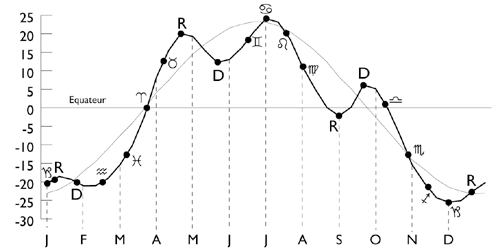
▶ From 3rd to 24th January: retrogradation in Capricorn.
▶ From 27th April to 21st May: retrogradation in Taurus.
▶ On 21st August, eight days before the start of its retrogradation, it is at 23° 52′ in Virgo in ecliptic coordinates, but its declination is 0° 15′ south. Even before being retrograde, it already has a 0° Libra type rhythm…
▶ From 29th August to 21st September: retrograde in ecliptic Virgo. But until 9th September, it still has a Libra declination, meaning that for mid-northern hemisphere latitude, it has a Pisces-like photoperiodic rhythm!
Fig. 2: Mercury in 2004
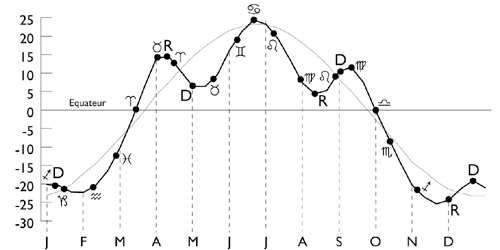
▶ From 7th April to 1st May: retrogradation in Taurus then in Aries.
▶ From 12th August to 3rd September: retrogradation in Virgo then in Leo.
Fig. 3: Mercury in 2005
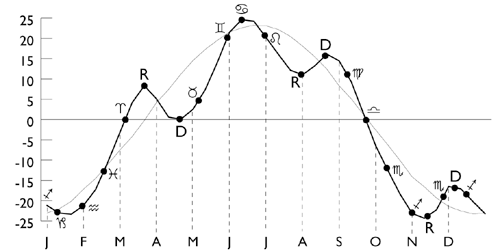
▶ From 21st March to 13th April: retrogradation in Aries. Due to its very high ecliptic latitude, Mercury is close to crossing the equator a second time when it resumes its direct direction. Phew! It almost turned into Mercury-Pisces in declination.
▶ From 15th November to 5th December: retrogradation in Scorpio.
Fig. 4: Mercury in 2006
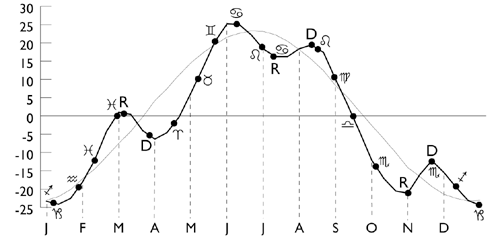
▶ On 27th February, it is at 25° 45′ of Pisces in a direct direction on the ecliptic, but at 0° 13′ of northern declination: it should therefore be interpreted as Mercury-Aries until 11th March, date on which it crosses below the equator in the southern hemisphere. But since it is retrograde from 3rd to 26th March, things get a little complicated: from 27th February to 3rd March, this ecliptic Mercury-Pisces in the direct direction should be interpreted as Mercury-Aries; then from 4th to 11th March, during its retrogradation, it should be interpreted as a Mercury-Aries disturbed by its Virgo photoperiod; finally, from 11th to 26th March, it should be interpreted as a Mercury-Pisces disturbed by its Libra photoperiod…
▶ From 5th to 30th July: retrogradation in Leo then Cancer.
▶ From 29th October to 19th November: retrogradation in Scorpio.
Fig. 5: Mercury in 2007
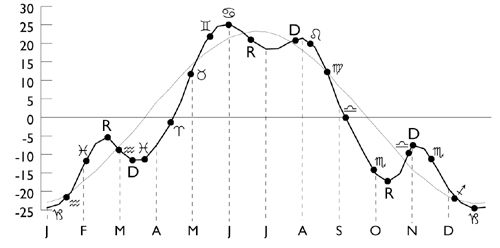
▶ From 15th February to 9th March: retrogradation in Pisces then in Aquarius.
▶ From 16th June to 19th July: retrogradation in Cancer.
▶ From 13th October to 2nd November: retrogradation in Scorpio then in Libra.
Fig. 6: Mercury in 2008
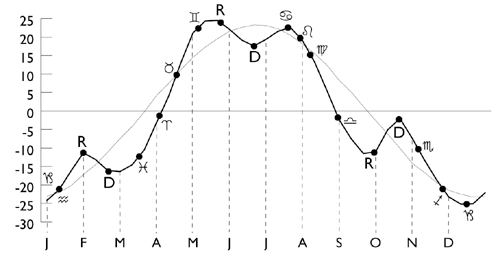
▶ On 2nd April, it is at 0° 28′ of Aries in direct direction on the ecliptic, but at 1° 46′ of southern declination: it should therefore be interpreted as a Mercury-Pisces until 6th April, date on which it actually passes over the equator in the northern hemisphere.
▶ From 27th May to 20th June: retrogradation in Gemini.
▶ From 25th September to 16th October: retrogradation in Libra.
Fig. 7: Mercury in 2009
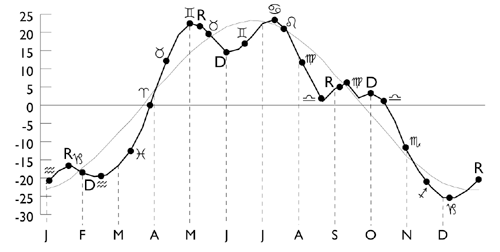
▶ From 12th January to 1st February: retrogradation in Aquarius then in Capricorn.
▶ On 26th March, Mercury is at 0° 20′ Aries direct on the ecliptic, but at 1° 26′ south declination: it should therefore be interpreted as Mercury-Pisces until 28th March, date on which it actually passes over the equator in the northern hemisphere.
▶ From 9th May to 1st June: retrogradation in Gemini then in Taurus.
▶ On 22nd August, Mercury is at 24° 27′ from Virgo direct on the ecliptic, but at 0° 04′ south declination: it should therefore be interpreted as Mercury-Libra until 26th August, the date on which Mercury “officially” enters Libra on the ecliptic.
▶ From 8th to 11th September: retrogradation in Libra then in Virgo. It gets complicated again: From 8th to 19th September, Mercury retrograde in Libra has a Pisces-like photoperiod. On 19th September, it retrogrades in Virgo but it still has a Libra declination: until 24th September, it should therefore also be interpreted as a Mercury-Libra disturbed by a Pisces rhythm. Then, from 24th to 30th September, it has a Virgo declination: it should therefore be interpreted as a Mercury-Virgo disturbed by an Aries rhythm…
Fig. 8: Mercury in 2010
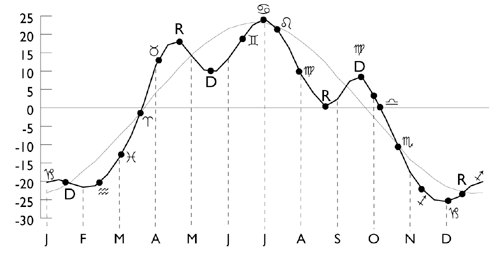
▶ From 19th April to 12th May: retrogradation in Taurus.
▶ From 21st August to 13th September: retrogradation in Virgo.
▶ On 4th October, it is at 0° 40′ of Libra in direct direction on the ecliptic, but at 1° 26′ of declination north: it should therefore be interpreted as Mercury-Virgo until 6th October, the date on which it actually passes below the equator, in the southern hemisphere.
▶ From 11th to 31st December: retrogradation in Capricorn then Sagittarius.
Fig. 9: Mercury in 2011
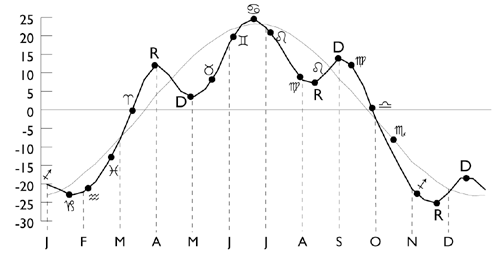
▶ From 31st March to 24th April: retrogradation in Aries.
▶ From 4th to 27th August: retrogradation in Virgo then Leo.
▶ On 26th September, it is at 0° 13′ of Libra in a direct direction on the ecliptic, but at 2° 28′ of declination north: it should therefore be interpreted as Mercury-Virgo until 28th September, the date on which it passes below the equator.
▶ From 25th November to 15th December: retrogradation in Sagittarius.
Fig. 10: Mercury in 2012

▶ From 13th March to 5th April: retrogradation in Aries then in Pisces. Return of complications: from 13th to 23rd March, Mercury-ecliptic does have an Aries declination: it should therefore be interpreted as a Mercury-Aries disturbed by Virgo-type photoperiodic rhythms; from 23rd to 29th March, it is in Virgo in ecliptic projection, but still has a northern declination: it should therefore also be interpreted as a Mercury-Aries disturbed by Virgo rhythms; finally, from 29th March to 5th April, it has a southern declination: it should therefore be interpreted as a Mercury-Pisces disturbed by Libra-type photoperiodic rhythms.
▶ From 16th July to 9th August: retrogradation in Leo.
▶ On 17th September, it is at 0° 03′ of Libra in a direct direction on the ecliptic, but at 1° 03′ of declination north: it should therefore be interpreted as Mercury-Virgo until 19th September, the date on which it actually crosses below the equator.
▶ From 7th to 27th November: retrogradation in Sagittarius then Scorpio.
▶ From 18th May to 30th June: retrogradation in Gemini:
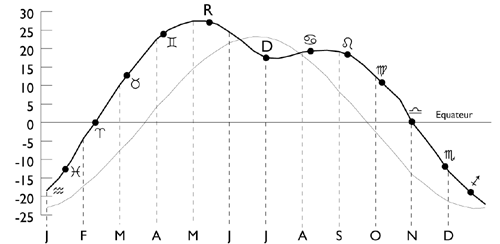
The retrogradation of Venus in 2007
▶ From 28th July to 9th September: retrogradation in Virgo then Leo:
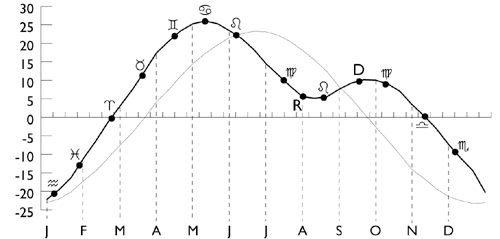
▶ Mars positions are calculated every 15 days. The retrogradation happens here in Pisces:
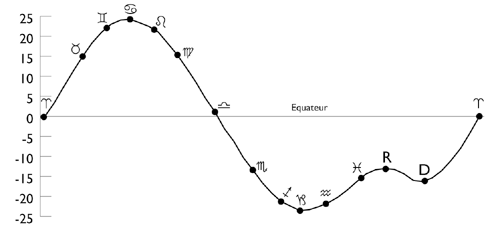
▶ The positions of Jupiter are calculated every three months:
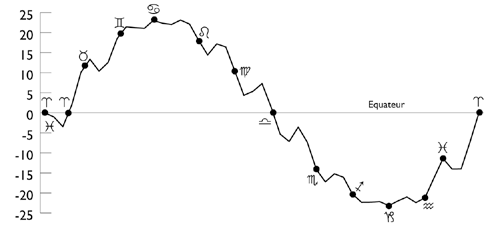
A retrogradation produces at least two characteristic effects:
▶ 1) The prolonged station of the retrograde planet in a portion of the zodiac;
▶ 2) The reversal of the photoperiodic rhythm of the retrograde planet.
The first effect immediately brings us back to one of the characteristics of conditioning: the longer a signal lasts, the more its perception by the nervous system intensifies and the more it is likely to react. This effect is particularly noticeable during periods of planetary transits. Transits of fast non-retrograde planets last for a short time. Assuming (arbitrarily) an orb of 10° before and after the exact conjunction or opposition aspect in transit, a transit of the Moon (which cannot be retrograde) lasts only one day and a transit of Mercury one ten days. On the other hand, a retrograde Mercury can transit for about a month on a natal planet…
In the natal chart, one can wonder if one of the effects of a planetary retrogradation (especially if it is a fast and dominant planet) would not be to accentuate the importance of the Sign where it is located. find. Indeed, she remains longer in this Sign during the neonatal period.
The second effect requires trying to deal rationally with the interaction between the effects of the “normal” Sign and those of the “abnormal” Sign (in photoperiod) induced by retrogradation. One of the most attractive hypotheses is proposed by Jean-Pierre Nicola: “it is possible that retrogradation accentuates the “phase effect” since it remains common to the Signs concerned… Not sure that this is an exclusively negative effect”.
 To illustrate this hypothesis, I will take an example: that of Mercury retrograde and dominant in Sagittarius (I am very concerned…). Technically, it is a question of interpreting the effects of the “transcendence of Representation” in Associative Excitation Strength, Inhibition Speed and Sense of Syntheses for the adapted pole (we will deal further with the unsuitable pole), knowing that for a birth in the temperate zone of the northern hemisphere, this Mercury has a Capricornian photoperiod, hence the need to interpret the irruptions of the Force and slowness of extinctive inhibition, always in Sense of Syntheses, inside the sagittarian mechanisms.
To illustrate this hypothesis, I will take an example: that of Mercury retrograde and dominant in Sagittarius (I am very concerned…). Technically, it is a question of interpreting the effects of the “transcendence of Representation” in Associative Excitation Strength, Inhibition Speed and Sense of Syntheses for the adapted pole (we will deal further with the unsuitable pole), knowing that for a birth in the temperate zone of the northern hemisphere, this Mercury has a Capricornian photoperiod, hence the need to interpret the irruptions of the Force and slowness of extinctive inhibition, always in Sense of Syntheses, inside the sagittarian mechanisms.
The accentuation of the phase effect (Sense of Syntheses-ultraparadoxical phase common to the Solstitial Signs Gemini, Cancer, Sagittarius, Capricorn) seems to impose itself: indeed, this retrograde Mercury spends more time in the ultraparadoxical phase than a non-retrograde Mercury (see above). And I think like Jean-Pierre Nicola that its effects are not necessarily negative, contrary to what traditional astrology asserted, for which retrogradations were part of “debilitated”.
So let’s start by trying to imagine and understand what the positive effects of such a retrogradation might be.
A Mercury-Sagittarius “adapted” encourages us to open up very widely to the whole range of possibilities, to multiply the most distant and disparate curiosities and centers of interest while constantly seeking to associate them with each other, to find common points in them, comparisons, resemblances by comparing them quickly. His thirst for new information seems inexhaustible, infinite: he wants to be interested in everything and the rest beyond all divisions, all borders and all apparently irreducible dualities. He forages in a vast panorama whose horizon recedes indefinitely. The positive effect of retrogradation in Capricorn rhythm could be the following: punctually or periodically, this Mercury-Sagittarius feels the need to move from an open set to a closed set, to put a temporary stop to his thirst for new information to bring order to it, to structure its content, to explore its ramifications and the implicit order at a given moment of its questionings, interrogations and research. During this lapse of time, he is no longer interested in everything and in the rest, he puts an extinguisher on the external signals which could solicit his curiosity: he browses in what he has accumulated, in all that remains to him, in this network that he has built and that he freezes temporarily. Positive effects when he leaves in the direct direction, in the Sagittarius direction: having been able to identify and eliminate, during his Capricorn-retrograde phase, certain inessential connections, certain useless associations, certain misleading resemblances, he can once again open up to all fields possible by being relieved of everything that was not essential to his progress: he thus achieved great energy savings while putting a little order in his Sense of Syntheses.
Now let’s see what some of the negative effects could be. This time, the Capricornian closures are brutal, untimely, unsuited to the situation. Contact is cut without warning, at inopportune moments, to put a confused and illusory false order in the unstructured thicket of its multiple curiosities. The alert and light-hearted conversation turns into rambling monologue. We have the impression of being connected to the essential, of having reached the absolute, of knowing everything that remains to be known, whereas we have simply frozen our various knowledge. We go around in circles fluttering in its bric-a-brac of eclectic and mismatched knowledge, temporarily deaf to any new contribution, to any new information, even the most relevant and the most interesting. Passed this more or less long moment of “tiredness”, we then go back to the front as if nothing had happened without realizing that we have thus confused everything. To “redo”, Mercury-Sagittarius, again direct, then risks for a time or for a long time falling into maladjustment: in reaction to this untimely and ineffective closure, he may be tempted to indulge in the lack of blocking inhibition: his bulimia of information no longer has any brakes or limits, it will associate everything and anything in a joyful unifying enthusiasm; to the slowness of unsuitable excitement: nothing will be able to divert him from his relentless and chimerical desire to associate all his centers of interest; to the ultraparadoxical phase: he will mix everything in an unconscious and offhand rejection of any Sense of Opposites…
Of course, the descriptions of the hypothetical positive or negative effects of this Mercuro-Sagittarian retrogradation are caricatural because extreme. The actual effects will likely be more nuanced most of the time and will vary depending on the situations one is dealing with. And it seems to me that the best way to observe them experimentally is to look at the periods when Mercury is in retrograde transit in Sagittarius.
I am not going to offer you the interpretations of all the retrograde planets. Not the courage for now, and something else to do. So it’s up to you to look into this problem yourself and try to see what effects all the retrogradations can produce. Personally, it seems to me that with a Mercury retrograde in Sagittarius I often function as I have described. And you, how do you experience your retrograde planets (if you have any in your birth sky)?
Article published in issue No. 20 of the Fil d’ARIANA (October 2003).
▶ The astronomical reality of the zodiac
▶ The human reflexology zodiac
▶ Elementary astronomy of the solar system
▶ Black Moon and lunar Nodes
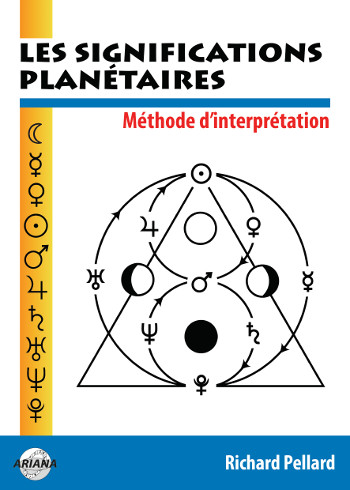
Les significations planétaires
par
620 pages. Illustrations en couleur.
La décision de ne traiter dans ce livre que des significations planétaires ne repose pas sur une sous-estimation du rôle des Signes du zodiaque et des Maisons. Le traditionnel trio Planètes-Zodiaque-Maisons est en effet l’expression d’une structure qui classe ces trois plans selon leur ordre de préséance et dans ce triptyque hiérarchisé, les Planètes occupent le premier rang.
La première partie de ce livre rassemble donc, sous une forme abondamment illustrée de schémas pédagogiques et tableaux explicatifs, une édition originale revue, augmentée et actualisée des textes consacrés aux significations planétaires telles qu’elles ont été définies par l’astrologie conditionaliste et une présentation détaillée des méthodes de hiérarchisation planétaire et d’interprétation accompagnées de nombreux exemples concrets illustrés par des Thèmes de célébrités.
La deuxième partie est consacrée, d’une part à une présentation critique des fondements traditionnels des significations planétaires, d’autre part à une présentation des rapports entre signaux et symboles, astrologie et psychologie. Enfin, la troisième partie présente brièvement les racines astrométriques des significations planétaires… et propose une voie de sortie de l’astrologie pour accéder à une plus vaste dimension noologique et spirituelle qui la prolonge et la contient.
Téléchargez-le dès maintenant dans notre boutique
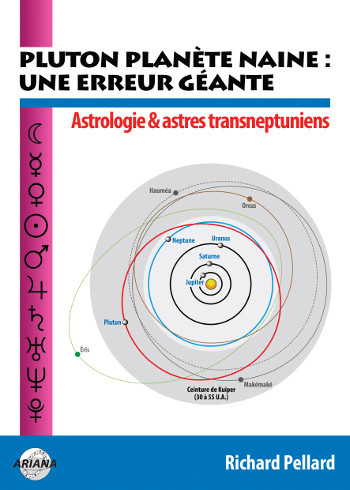
Pluton planète naine : une erreur géante
par
117 pages. Illustrations en couleur.
Pluton ne fait plus partie des planètes majeures de notre système solaire : telle est la décision prise par une infime minorité d’astronomes lors de l’Assemblée Générale de l’Union Astronomique Internationale qui s’est tenue à Prague en août 2006. Elle est reléguée au rang de “planète naine”, au même titre que les nombreux astres découverts au-delà de son orbite.
Ce livre récapitule et analyse en détail le pourquoi et le comment de cette incroyable et irrationnelle décision contestée par de très nombreux astronomes de premier plan. Quelles sont les effets de cette “nanification” de Pluton sur son statut astrologique ? Faut-il remettre en question son influence et ses significations astro-psychologiques qui semblaient avérées depuis sa découverte en 1930 ? Les “plutoniens” ont-ils cessé d’exister depuis cette décision charlatanesque ? Ce livre pose également le problème des astres transplutoniens nouvellement découverts. Quel statut astrologique et quelles influences et significations précises leur accorder ?
Enfin, cet ouvrage propose une vision unitaire du système solaire qui démontre, chiffes et arguments rationnels à l’appui, que Pluton en est toujours un élément essentiel, ce qui est loin d’être le cas pour les autres astres au-delà de son orbite. Après avoir lu ce livre, vous saurez quoi répondre à ceux qui pensent avoir trouvé, avec l’exclusion de Pluton du cortège planétaire traditionnel, un nouvel argument contre l’astrologie !
Téléchargez-le dès maintenant dans notre boutique